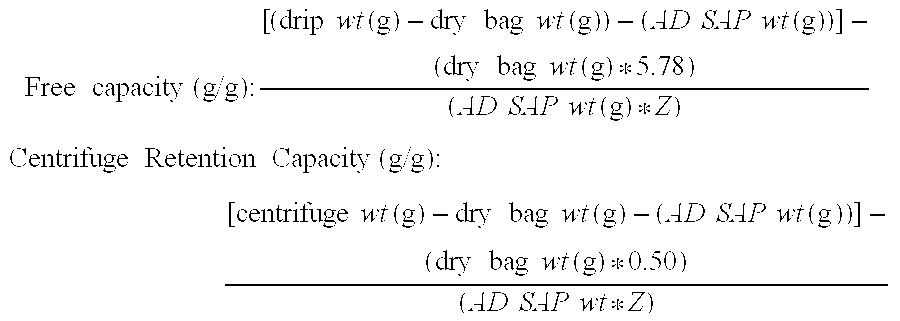Methods for the preparation of superabsorbent particles containing carboxyalkyl cellulose
a technology of carboxyalkyl cellulose and superabsorbent particles, which is applied in the direction of cellulosic plastic layered products, other chemical processes, separation processes, etc., can solve the problems of high cost, inefficiency in sap use, and large amount of interstitial liquid in the produ
- Summary
- Abstract
- Description
- Claims
- Application Information
AI Technical Summary
Problems solved by technology
Method used
Image
Examples
example 1
The Preparation of Representative Superabsorbent Particles (Flakes): Ammonium Zirconium Carbonate and Boric Acid Crosslinking
[0069]In this example, the preparation of representative superabsorbent composite crosslinked with ammonium zirconium carbonate is described.
[0070]Prepare a solution of CMC 9H4F 10.0 g OD in 900 ml deionized water with vigorous stirring to obtain a smooth solution. Fully dissolve 0.6 g guar gum in 50 ml DI water and mix well with the CMC solution. Mix the solution for further one hour to allow complete mixing of the two polymers.
[0071]Blend the polymer mixture in the blender for 5 minutes. Fully dissolve boric acid 0.1 g in 30 ml DI water. Dilute 2.0 g ammonium zirconium carbonate solution (15% ZrO2) with 20 ml DI water. Transfer ammonium zirconium carbonate solution and boric acid solution to the polymer solution and blend for 5 minutes. Pour the gel into a Teflon coated pan and dry in the oven at 60° C. Grind the dry film in a coffee grinder and sieve. Colle...
example 2
The Preparation of Representative Superabsorbent Particles (Flakes): Aluminum Sulfate / Boric Acid Crosslinking
[0073]In this example, the preparation of representative superabsorbent composite crosslinked with aluminum sulfate and boric acid is described.
[0074]Prepare a solution of CMC 9H4F 10.0 g OD in 900 ml deionized water with vigorous stirring to obtain a solution. Dissolve 0.6 g guar gum in 50 ml DI water and mix well with the CMC solution. Mix the solution for further one hour to allow complete mixing of the two polymers.
[0075]Blend the polymer mixture in the blender for 5 minutes. Fully dissolve boric acid 0.1 g in 30 ml DI water. Dissolve 0.4 g aluminum sulfate octadecahydrate 20 ml DI water. Transfer boric acid solution and aluminum sulfate solution to the polymer solution and blend for 5 minutes to mix well. Pour the gel into a Teflon coated pan and dry in the oven at 60° C. Grind the dry film in a coffee grinder and sieve. Collect 300-800 μm fraction for testing.
[0076]T-ba...
example 3
The Preparation of Representative Superabsorbent Particles (Flakes): Tyzor TE and Boric Acid Crosslinking
[0077]In this example, the preparation of representative superabsorbent composite crosslinked with Tyzor TE and boric acid is described.
[0078]Prepare a solution of CMC 9H4F 10.0 g OD in 900 ml deionized water with vigorous stirring to obtain a smooth solution. Dissolve 0.6 g guar gum in 50 ml DI water and mix well with the CMC solution. Mix the solution for further one hour to allow complete mixing of the two polymers.
[0079]Blend the polymer mixture in the blender for 5 minutes. Dissolve boric acid 0.2 g in 30 ml DI water. Dilute 0.2 g Tyzor TE with 20 ml DI water. Transfer Tyzor TE solution and boric acid solution to the polymer solution and blend for 5 minutes to mix well. Pour the gel into a Teflon coated pan and dry in the oven at 60° C. Grind the dry film in a coffee grinder and sieve. Collect 300-800 μm fraction for testing.
[0080]T-bag test for free swell 43.92 g / g; centrif...
PUM
| Property | Measurement | Unit |
|---|---|---|
| size | aaaaa | aaaaa |
| length | aaaaa | aaaaa |
| size | aaaaa | aaaaa |
Abstract
Description
Claims
Application Information
 Login to View More
Login to View More - R&D
- Intellectual Property
- Life Sciences
- Materials
- Tech Scout
- Unparalleled Data Quality
- Higher Quality Content
- 60% Fewer Hallucinations
Browse by: Latest US Patents, China's latest patents, Technical Efficacy Thesaurus, Application Domain, Technology Topic, Popular Technical Reports.
© 2025 PatSnap. All rights reserved.Legal|Privacy policy|Modern Slavery Act Transparency Statement|Sitemap|About US| Contact US: help@patsnap.com

